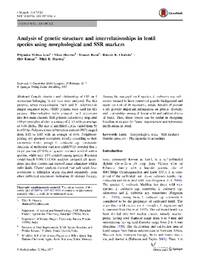Analysis of genetic structure and interrelationships in lentil species using morphological and SSR markers

Authors:
Genetic structure and relationships of 130 lentil accessions belonging to six taxa were analysed. For this purpose, seven morphological traits and 31 polymorphic simple sequence repeat (SSR) primers were used for this purpose. Morphological traits grouped lentil accessions into five main clusters. SSR primers collectively amplified 139 polymorphic alleles in a range of 2–10 with an average of 4.48 alleles. The size of amplified alleles varied from 50 to 650 bp. Polymorphism information content (PIC) ranged from 0.02 to 0.85 with an average of 0.46. Neighbour-joining tree grouped accessions broadly according to their taxonomic ranks, except L. culinaris ssp. odemensis. Analysis of molecular variance (AMOVA) revealed that a major portion (82.0%) of genetic variance resided within species, while only 18% resided among species. Bayesian model-based STRUCTURE analysis assigned all accessions into five clusters and showed some admixture within individuals. Cluster analysis showed that cultivated Lensaccessions of Ethiopian origin clustered separately, from other cultivated accessions indicating its distinct lineage. Among the analysed lentil species, L. culinaris ssp. odemensis seemed to have conserved genetic background and needs revision of its taxonomic status. Results of present study provide important information on genetic diversity and relationships among different wild and cultivated taxa of lentil. Thus, these results can be useful in designing breeding strategies for future improvement and taxonomic implications in lentil.
